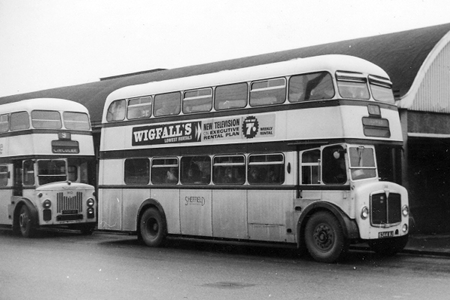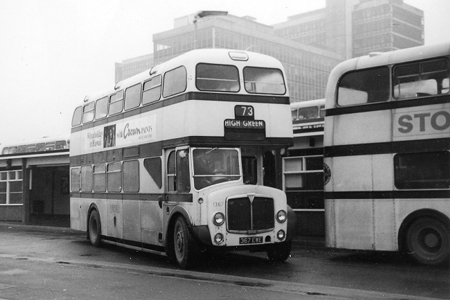Sheffield Bus Bodies
Sheffield Bus Bodies
A lot has been said about Sheffield not having a standard bus - unlike London, Manchester and Birmingham. This may have been true but, apart from those quirky deliveries to spice up the life of a gricer, Sheffield did adhere to a fairly strict dual order policy. From the '20s until mid '60s this meant Leylands and AECs. Until AEC gradually left the double deck stage and were replaced by Daimler, the only deviations from this dualling policy were during WW2 and immediately afterwards when vehicles were hard to get and, almost, anything was better than nothing.
From the very first AEC Regent in the early '30s, Weymann became a major supplier - principally on AEC and pre-war Leyland, Cravens and Roberts were the other body suppliers - principally on Leyland, although Roberts also built on AEC. After WW2 this continued, although Cravens, Roberts - and also NCB - were additional builders on Regent IIIs.
It was not until very late, 1951, that Roe came on the scene in Sheffield and, after Leyland closed down their body shop, shared the privilege of bodying almost all vehicles with Weymann. This only ended in 1962/3.
Roe built composite bodies with teak frames to a superbly high standard and with a stylish design. This evolved from the Leeds Pullman until the last delivery, on Daimler CVG6, to Northampton Corporation in 1968. The classic post war Leeds Pullman of 1949-51 was the first Roe design to arrive in Sheffield on nine Leyland PD2s and soon after nine AEC Regent IIIs - the first manual Regent IIIs in the city. [They should have been synchromesh, but production difficulties saw them arrive with crash boxes. The synchro boxes were retrofitted a year or so later.]
 Ten more Regent IIIs arrived in 1953 - one figured on this site last year. There was a variant of the body style which was almost exclusive to the hundreds of utility Guys and Daimlers rebodied by Roe in 1952/3. The best known example of this is Steve Morris's J Wood of Mirfield Crossley - itself a rebody. The 1953 Sheffield Regent IIIs had a four bay body with window and frontal profile closely related to the rebody style.
Ten more Regent IIIs arrived in 1953 - one figured on this site last year. There was a variant of the body style which was almost exclusive to the hundreds of utility Guys and Daimlers rebodied by Roe in 1952/3. The best known example of this is Steve Morris's J Wood of Mirfield Crossley - itself a rebody. The 1953 Sheffield Regent IIIs had a four bay body with window and frontal profile closely related to the rebody style.
1956 saw the delivery, on Regent III, of the first of many Roe bodies, to the most common and best known profile, which culminated in the twenty-five Regent Vs, like B fleet 1344, delivered in 1960. These were part of a batch of seventy-one similar Regent Vs - the others were twenty-six Weymann and twenty Alexander bodies. Pre WW2, nearly all the AECs were Weymann bodied but after the demise of Leyland bodies both builders had a share of both Leyland and AEC chassis.
 This picture of 1344 shows a Roe bodied Leyland PD3 trying to muscle in. These were delivered a year earlier, in 1959, with essentially the same body but with significant differences. The Regent Vs were the only Roe bodies delivered with front screen ventilators; they also had platform doors and emergency doors. The PD3s had standard open platforms but there were about half a dozen PD2s with similar platform doors, the last one a sole 1960 registration. The PD3s were the last bodies - by Roe or anyone else - to have comprehensive side slider ventilators; the Regent Vs began the era of sliders every alternate window.
This picture of 1344 shows a Roe bodied Leyland PD3 trying to muscle in. These were delivered a year earlier, in 1959, with essentially the same body but with significant differences. The Regent Vs were the only Roe bodies delivered with front screen ventilators; they also had platform doors and emergency doors. The PD3s had standard open platforms but there were about half a dozen PD2s with similar platform doors, the last one a sole 1960 registration. The PD3s were the last bodies - by Roe or anyone else - to have comprehensive side slider ventilators; the Regent Vs began the era of sliders every alternate window.
Even then, there was something to keep the interest. The Regent Vs were built late 1959 and the first were registered and put into service on 1st January 1960. Half of them were not put into service until April 1960 - along with the Alexander and Weymann examples. The two subsets of Roe bodies had differing slider layout. 1344 was a Leadmill, seen at Pond Street Bus Station on service 59 to Bradway. Leadmill buses had an extra set of sliders downstairs - those immediately behind the engine or the driver. East Bank buses did not have these - only two sets each downstairs.
I was fortunate enough to live at Greenhill on the Derbyshire/Peak District border and to be served by the 38 Low Edges (East Bank), 59 Bradway and 22 Holmesfield (Leadmill) which gave three opportunities to ride the Roe/Regent Vs.
They were also the first Sheffield buses fitted, from new, with heating upstairs as well as downstairs - and I hated them in winter. Sheffield is beautifully mountainous and made for long hauls up hill in third gear on an AEC. The Regent V heaters were horrendously noisy but only worked when the bus was moving. At a bus stop, not a sound, but when you wanted to hear the engine or gearbox it was drowned out by the noise of the heaters!!!
not a sound, but when you wanted to hear the engine or gearbox it was drowned out by the noise of the heaters!!!
Some of the Weymann Regent Vs had exhaust brakes, but none of the Roes. Now that would have been perfection.
After that, things fell apart and went downhill as Park Royal metal frames, and some of the ugliest buses they have ever produced, gradually took over at Crossgates. But we have our memories - and maybe 1330 will eventually emerge in shining glory at The South Yorkshire Transport Museum Aldwarke, Rotherham.
David Oldfield
01/2010
Comments regarding the above are more than welcome please get in touch via the 'Contact Page' or by email at obp-admin@nwframpton.com
If you have a bus related article that you would like to appear on this site please get in touch via the 'Contact Page' or by email at obp-admin@nwframpton.com
All rights to the design and layout of this website are reserved
Old Bus Photos from Saturday 25th April 2009 to Wednesday 3rd January 2024